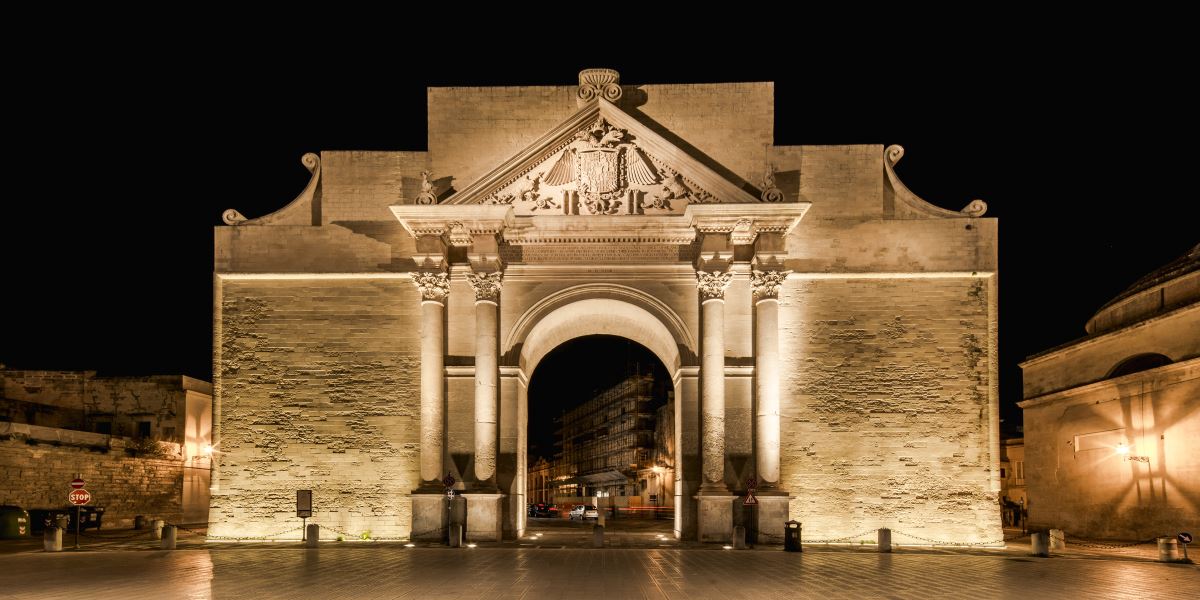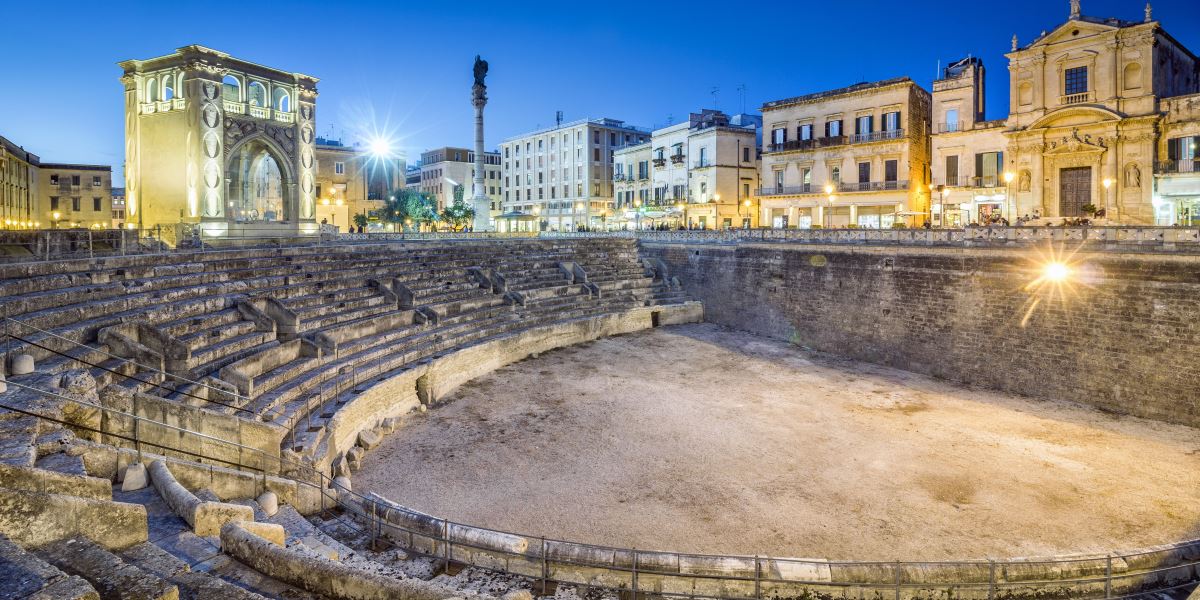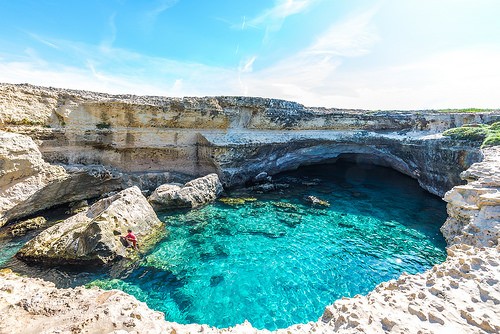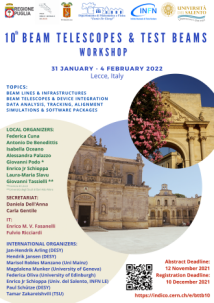Welcome to Lecce !!!
Information on the workshop venue:
- the plenary sessions will take place in Room n. 7 of the Studium 2000 building
- the hands-on sessions will be held in the nearby Olivetani ex Monastery
Information about the locations of the social events will be given at the workshop.
Join us in a trip of the town: https://www.youtube.com/watch?v=eO02PPLbSHI
University of Salento youtube video
Lecce (Salentino: Lècce) is a city in the Apulia region of Italy.
It is located in the middle of the heel of Italy, in the center of the so called Salento land. The proximity to the two coasts (the Adriatic and the Ionan one) makes Lecce a very attractive holiday destination, especially during summer. The city is characterized by the richness of the Baroque art, which can be admired in several churches and buildings. Lecce was built during the 3rd century BC, but it developed mostly between the 7th and the 4th century BC. After the Roman domination, the city was sacked by the Ostrogoths and subsequently dominated by different populations, among which the Byzantine and the Norman. In the 15th century it became one of the most important cities in the south of Italy, and in the following century several defensive monuments were built, among which Porta Napoli.
This monument is built using a material called pietra leccese, a type of rock typical of Salento used to build many constructions in the whole region. The use of this material gives a special luminosity to the city, a characteristic that often fascinates tourists.

What to visit in Lecce
The Dome
It's the main place of worship of the city. It seems that the beginning of its construction dates back to the 12th century, before the Baroque era. The structure is characterized by the particular presence of two facades. The main façade is the less decorated one, while the northern façade is richer and fully embodies the spirit of Baroque. Noteworthy is the bell tower that overlooks the entire city (70 meters tall), built after the collapse of the previous Norman tower. The interior of the building, with a Latin cross plan, is divided into 3 naves and houses 12 altars.
Castle of Charles V
 The castle is a symbol of the Habsburg domination in the territory and its construction took place at the behest of Charles V of Habsburg in 1539. The current structure was built on a previous medieval construction in order to improve the defensive capabilities of the territory, especially because of its proximity to both coasts. The building has a quadrangular shape characterized by the presence of four bastions. On each door there was the Habsburg emblem and even today the double-headed eagle can be seen on one of the walls of the inner courtyard. The building has been remodeled several times over the centuries and many changes have been made. A careful observer will easily spot on the walls delimiting the castle perimeter the evidences left by the use of defensive cannons.
The castle is a symbol of the Habsburg domination in the territory and its construction took place at the behest of Charles V of Habsburg in 1539. The current structure was built on a previous medieval construction in order to improve the defensive capabilities of the territory, especially because of its proximity to both coasts. The building has a quadrangular shape characterized by the presence of four bastions. On each door there was the Habsburg emblem and even today the double-headed eagle can be seen on one of the walls of the inner courtyard. The building has been remodeled several times over the centuries and many changes have been made. A careful observer will easily spot on the walls delimiting the castle perimeter the evidences left by the use of defensive cannons.
Church of Santa croce
The highest expression of the Baroque art in Lecce is the church of Santa Croce. Its construction began in the 16th century and ended only a century later. Some of the most important architects took part in this project. The self-portrait of one of them, Antonio Zimbalo, can be seen on the facade, next to the big rose-window that characterizes the upper part. It also houses statues of allegorical animals, Aragonese and Ottoman soldiers, religious figures and the Lupa Capitolina. The lower part of the facade is divided into 3 sections by 6 columns and has 3 doors. Inside the church several paintings, altars and statues can be admired.
Roman amphitheater
Of very high historical value is certainly the Roman amphitheater, whose history is linked to that of the one in Rome. It seems in fact that Augustus, before becoming emperor in the first century AD, had found refuge in the ancient Lupiae (Lecce's name in Roman times) and to thank for the hospitality he ordered the construction of both structures. The amphitheater was discovered by chance in 1929 following some excavations in the gardens of two private palaces. Part of the cavea of the amphitheater was brought to light, carved directly into the rock and originally able to accommodate about 5000 spectators. The statues that decorated the amphitheater were also found; they date back to the age of the emperors Antonini and today they can be visited in the museum adjacent to the amphitheater.

Church of Santa Chiara

The construction of the church began in 1429, prior to the Baroque period. However, the structure was completed only in 1691 by the architect Giuseppe Cino. The external façade does not present the original fastigium and it is divided into two convex sections separated by a decorative frame. The floor plan of the church is octagonal, a not very common feature. The interior fully represents the Baroque art: twisted columns, stuccoes, cartouches and decorations of all kinds were meant to amaze the visitor. The altars are decorated with valuable wooden sculptures of the Neapolitan school of the late 17th century.
What to visit on Salento coasts
One of the main attractions of Salento is the sea. In its 150 km of coasts several landscapes follow each other: sandy beaches, cliffs, caves and also nature reserves.
If you want to explore the Adriatic coast you can visit Castro. Here you can enjoy the view of the sea from the entrance of a karst cave, called Grotta della Zinzulusa. It was discovered more than 150 years ago, but it was made accessible to the public in the 50s. Inside the cave it is possible to admire impressive stalactites, stalagmites and the point in which fresh and salt water meet. On the same coast, a mandatory destination for the cliff lovers is Roca. Here it is possible to swim in one of the 10 most beautiful natural pools in the world, called la Poesia. Inside it, a Messapian place of worship has recently been discovered.
On the Ionian coast instead you can visit Porto Selvaggio, a natural reserve that surrounds the beach with a total of 432 hectares of coastline. On the same coast you can find Porto Cesareo: long stretches of fine sands alternate with natural dunes up to 8 meters high and characterized by the Mediterranean scrub. For the adventure lovers it is possible to snorkel, kitesurfing or go sailing. Even inexperienced people can try these activities thanks to the many courses available for tourists.




What you must eat in Lecce
Pasticciotto

If you come to Lecce it is mandatory to try the pasticciotto, a baked dessert made of shorty pastry filled with custard.
According to legend, the first pasticciotto was created by chance in Galatina, a small town in the province of Lecce where in 1745 a baker decided to use the pastry left over from other desserts to make a small cream cake. He donated the pastry to a man who was walking by his shop, who appreciated it so much that he asked the baker for more pastries to bring to his family. Even though this might be only a legend, the success that the pasticciotto had in the last centuries is beyond any doubt.
In summer the pasticciotto can be enjoyed at breakfast accompanied by a cup of coffee with ice and almond milk. It is a coffee variation that you can find only in Salento, very well appreciated for its refreshing flavour.
Rustico

If you prefer a salty meal you can easily find in any bar of the region the rustico leccese. Mozzarella, bechamele sauce and tomatoes are inside layers of puff pastry. Salt and pepper are also used to give more taste to this street food, that is baked in the oven. The origin of the rustico is unknown; it was probably invented after the 18th century, when the puff pastry spread across Europe. Experts agree that the rustico was born in aristocratic circles, where these refined ingredients were used.
Salento today
Local customs

During town festivals it is really common to attend a performance of the local dance, known as pizzica. The pizzica has very ancient origins that seem to date back to the Dionysian cults, coming from Greece and very common in the area of Salento. The word "pizzica" means the bite of a tarantula. A person bitten by the tarantula would fall into a state of shock from which only music could awaken him/her; specialized musicians would rush to play and people would dance until he/she could cancel the effect of the poison. This represented a liberating and collective moment during which people were estranged from the constraints and moral rules of the community.
In the last fifteen years in Salento, some musicians and dancers have spread a neo-pizzica. Despite it being different from the traditional dance it has been very successful among young people, especially in the summer evenings at the music clubs.
Salento landscapes for events
The charm of art, the excellent Mediterranean cuisine and the sincere hospitality make Salento a very desirable destination for those who want to have a vacation. The growing notoriety of the wonderful landscapes has led Salento to be the location of several films, concerts and parades. Also Dior chose Lecce, its customs and music, to host a glamorous fashion show. The square outside the Dome, decorated with majestic illuminations, set the scene for the show, that was a magical mixture of fashion, music and dance.


